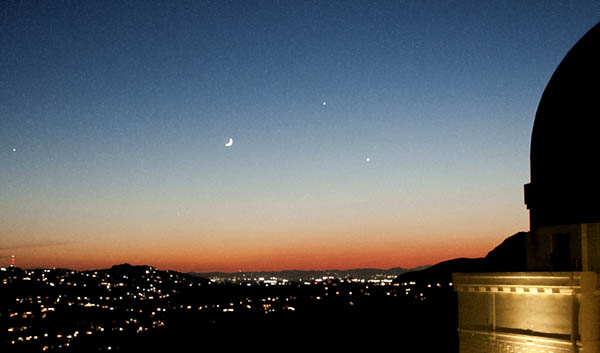
![]() LISTEN to this week’s Sky Report
LISTEN to this week’s Sky Report
This is the Griffith Observatory Sky Report for the week ending Wednesday, June 19, 2013. Here is what’s happening in the skies of Southern California:
The brightest planet, Venus, and the innermost planet, Mercury, continue to appear together during evening twilight. Look just above the west-northwest horizon at 8:35 p.m.–30 minutes after sunset–to see Venus. This week, Mercury will start out a few degrees to the upper left of Venus, and will gradually move, appearing 2˚ to the left of Venus on the 18th. Through a telescope, both planets appear small, Venus displaying a full phase and Mercury showing a crescent. Mercury becomes easier to see as the sky darkens and can be observed until about 9:00 p.m.
The ringed planet, Saturn is high in the south and appears 12 degrees to the east of Virgo the Maiden’s bright star, Spica, as darkness falls. Saturn can be seen until it sets in the west-southwest at 3:00 a.m. Saturn is one of the objects featured through Griffith Observatory’s public telescopes, and is now ideally placed for viewing.
The waxing moon grows from crescent to first-quarter phase on Sunday the 16th, and is gibbous through the 22nd. The moon is between the star Spica and the planet Saturn on Tuesday the 18th. This week, the time of moonset advances about 30 minutes each night, changing from 10:53 p.m. on the 12th to 2:20 a.m. on the 19th.
Free views of the sun during the day and of the moon, planets, and other celestial objects at night, are available to the public in clear weather through Griffith Observatory’s telescopes Tuesday-Sunday before 9:30 p.m. Check our website for our schedule. The next public star party on the grounds of Griffith Observatory, hosted by the Los Angeles Astronomical Society, the Sidewalk Astronomers, and the Planetary Society, will take place on Saturday, June 15.
From Griffith Observatory, I’m Anthony Cook and I can be reached at griffithobserver@gmail.com.
